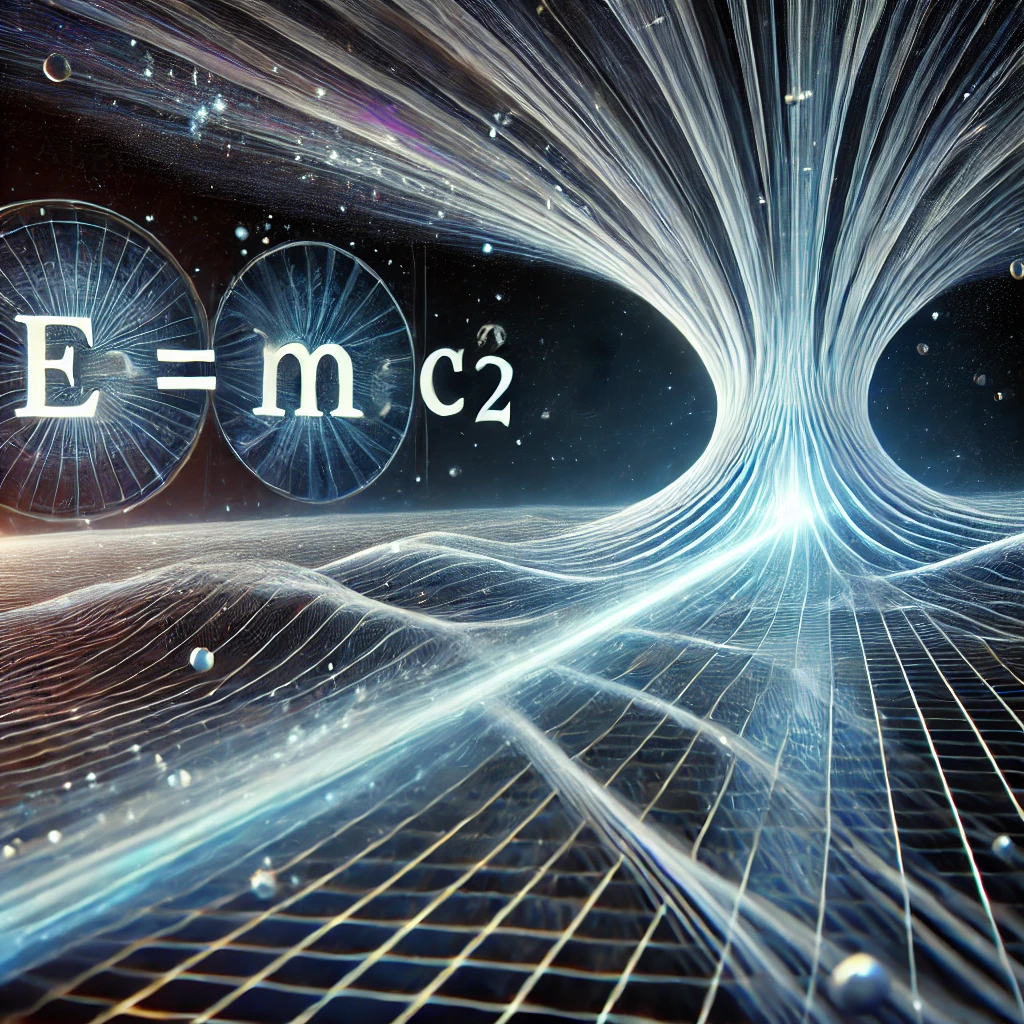المحتويات:
مقدمة
في نهاية القرن التاسع عشر، أعتقد العلماء أنهم تعلموا معظم ما يجب معرفته عن الفيزياء, قوانين نيوتن للحركة ونظريته عن الجاذبية، نتائج ماكسويل النظرية في توحيد الكهرباء المغناطيسية، وقوانين الديناميكا الحرارية وغيرها مما أستخدمت طرقاً رياضية لتفسير مجموعة متنوعة من الظواهر.
ومع ذلك في مطلع القرن العشرين هزت ثورة كبيرة عالم الفيزياء، في عام 1900 وضع بلانك حجر الأساس للفيزياء الحديثة بتقديم الأفكار الأساسية لنظرية الكم، وفي 1905 صاغ آينشتين نظريته النسبية الخاصة.
هاتين الفكرتين سيكون لهما تأثير كبير ومهم جداً في فهمنا للطبيعة والكون من حولنا, في غضون عدة عقود, ألهمت هذه النظريات الجديدة التطورات والنظريات في مجالات الفيزياء الذرية والنووية والمكثفة.
والقصة لم تنتهي بعد، الإكتشافات مازالت مستمرة وكما قال آينشتين( لقد كان وقتاً رائعاً للبقاء على قيد الحياة).
سرعة الضوء
بالنسبة ل النظرية النسبية الخاصة موجات الضوء وغيرها من أشكال الإشعاع الكهرومغناطيسي تنتقل عبر الفراغ(الفضاء الحر) بسرعة c=3.00×10^8 m/s، وتحدد هذه السرعة حداً أقصى لسرعات الجسيمات والموجات ونقل المعلومات. تتعامل تجاربنا اليومية غالباً مع الأشياء ذات سرعات أقل بكثير من سرعة الضوء.
الميكانيكا النيوتونية والنسبية.
ميكانيكا نيوتن والأفكار المبكرة عن الفضاء وصيغ الوقت التي تصف حركة الأشياء شكليات ناجحة جداً في وصف مجموعة واسعة من الظواهر، على الرغم من أن ميكانيكا نيوتن تعمل بشكل جيد للغاية عند السرعات المنخفضة، إلا أنها تفشل عند تطبيقها على الجسيمات التي تقترب سرعتها من سرعة الضوء. بشكل تجريبي، يمكن للمرء اختبار تنبؤات النظرية النيوتنية بسرعات عالية عن طريق تسريع الإلكترون من خلال فرق جهد كهربائي كبير. على سبيل المثال، من الممكن تسريع إلكترون إلى سرعة 0.99c(اي 99% من سرعة الضوء) باستخدام فرق جهد بمقدار عدة ملايين فولت. وفقًا لميكانيكا نيوتن، إذا إزداد فرق الجهد بمعامل 4 (اي ان الطاقة تضاعفت اربع مرات)، يجب أن تتضاعف سرعة الإلكترون إلى 1.98c ومع ذلك، تظهر التجارب أن سرعة الإلكترون_وكذلك سرعات جميع الجسيمات الأخرى في الكون_تظل دائمًا أقل من سرعة الضوء بغض النظر عن حجم الجهد المتسارع. يرجع ذلك جزئيًا إلى أن ميكانيكا نيوتن لا تضع حدًا أقصى للسرعة التي يمكن أن يصل إليها الجسيم، فإنها تتعارض مع النتائج التجريبية الحديثة، وبالتالي فهي نظرية محدودة بشكل واضح.
اكتشاف النظرية النسبية
في عام 1905، نشر ألبرت أينشتاين نظريته النسبية الخاصة عن عمر يناهز 26 عامًا. كتب أينشتاين عن النظرية النسبية :
نشأت النظرية النسبية للضرورة، من التناقضات الجادة والعميقة في النظرية القديمة التي يبدو أنه لا مفر منها.
قوة النظرية النسبية تكمن في الاتساق والبساطة التي تحل بها كل هذه الصعوبات، بإستخدام فقط عدد قليل من الافتراضات المقنعة للغاية.
الفرضيات التي تتبعها النظرية النسبية
إن النظرية النسبية الخاصة تنبع من اثنتين من الفرضيات الأساسية وهذه الفرضيات تتمثل في النقاط الآتية:
1_ قوانين الفيزياء هي نفسها في جميع الأنظمة المرجعية(جميع المراقبين أو الكائنات الواعية المشاهدة) التي تتحرك بشكل موحد فيما يتعلق ببعضها البعض.
أي أن القوانين الأساسية مثل F=dp/dt لها نفس الشكل الرياضي لجميع المراقبين الذين يتحركون بسرعة ثابتة بالنسبة لبعضهم البعض.
2_ تقاس سرعة الضوء في الفراغ دائمًا بـ 3×108 م / ث، والقيمة المقاسة لا تعتمد على حركة المراقب أو حركة مصدر الضوء. أي أن سرعة الضوء هي نفسها لجميع المراقبين الذين يتحركون بسرعات ثابتة.
تطبيقات النظرية النسبية
على الرغم من أنه من المعروف أن النسبية تلعب دورًا أساسيًا في الفيزياء النظرية، لها أيضًا تطبيقات عملية، على سبيل المثال، في تصميم مسرعات الجسيمات، ووحدات نظام تحديد المواقع العالمي (GPS)، وعروض التليفزيون عالية الجهد. لاحظ أن هذه الأجهزة لن تعمل ببساطة إذا تم تصميمها وفقًا لـ ميكانيكا نيوتن! سيكون لدينا فرصة لاستخدام نتائج النسبية في العديد من الموضوعات اللاحقة في هذا النص.
النظرية النسبية الخاصة هي المفتاح لتفسير الأمور والظواهر التي عجزت عن تفسيرها الميكانيكا الكلاسيكية منذ عصر نيوتن وهوك وكيبلر وغيرهم من علماء الفيزياء الكلاسيكية. كشف اسرار تلك الظواهر الغريبة كسرعة الضوء فتحت مجالات كثيرة وتطبيقات متطورة مكنت الإنسان من الوصول إلى أشياء ابعد من العالم الافتراضي كالفضاء والكون والسفر عبر الزمن.
Contents:
Introduction
By the end of the 19th century, scientists believed they had learned most of what needed to be known about physics. Newton's laws of motion and his theory of gravitation, Maxwell's theoretical results unifying electricity and magnetism, the laws of thermodynamics, and other advancements had used mathematical methods to explain a wide range of phenomena.
However, at the dawn of the 20th century, a major revolution shook the world of physics. In 1900, Planck laid the foundation for modern physics by introducing the basic ideas of quantum theory, and in 1905, Einstein formulated his Special Theory of Relativity.
These two ideas would have a profound and significant impact on our understanding of nature and the universe around us. Within just a few decades, these groundbreaking theories inspired advancements and theories in fields like atomic, nuclear, and condensed matter physics.
The story doesn’t end there discoveries continue to this day. As Einstein once said, “It was a wonderful time to be alive.”
Speed of Light
For the Special Theory of Relativity, light waves and other forms of electromagnetic radiation travel through a vacuum (free space) at a speed of C= 3.00 × 10⁸ m/s. This speed sets an upper limit on the velocities of particles, waves, and the transmission of information.
In our daily experiences, we typically deal with objects moving at speeds much slower than the speed of light.
Newtonian Mechanics and Relativity
Newtonian mechanics and early concepts of space and time, which describe the motion of objects, are highly successful in explaining a wide range of phenomena.
Although Newtonian mechanics works extremely well at low speeds, it fails when applied to particles moving at speeds approaching the speed of light.
Experimentally, one can test the predictions of Newtonian theory at high speeds by accelerating electrons through large electric potential differences.
For example, it is possible to accelerate an electron to a speed of 0.99C (99% of the speed of light) using a voltage of several million volts. According to Newtonian mechanics, if the voltage (and thus energy) is increased by a factor of 4, the electron's speed should double to 1.98C.
However, experiments show that the speed of the electron—like all other particles in the universe always remains less than the speed of light, regardless of the accelerating voltage.
This discrepancy arises because Newtonian mechanics does not impose a speed limit for particles, conflicting with modern experimental findings. Therefore, it is clearly a limited theory.
Discovery of the Theory of Relativity
In 1905, Albert Einstein published his Special Theory of Relativity at the age of 26.
Einstein wrote about relativity: “The theory of relativity originated from necessity, from serious and profound contradictions in the old theory that seemed inescapable. The strength of the theory lies in the consistency and simplicity with which it resolves all these difficulties, using only a few very compelling assumptions.”
Postulates of the Theory of Relativity
The Special Theory of Relativity arises from two fundamental postulates:
1_ The laws of physics are the same in all inertial reference frames (all observers or conscious entities moving uniformly relative to each other).
This means that fundamental laws, such as F =dp/dt, have the same mathematical form for all observers moving at constant velocities relative to one another.
2_ The speed of light in a vacuum is always measured to be 3×108, regardless of the motion of the observer or the motion of the light source.
This means that the speed of light is constant for all observers moving at constant velocities.
Applications of the Theory of Relativity
Although relativity is known for playing a fundamental role in theoretical physics, it also has practical applications.
For example, relativity is essential in the design of particle accelerators, GPS units, and high-voltage television displays. These devices simply wouldn’t function if they were designed based on Newtonian mechanics.
We will have the opportunity to apply the results of relativity in many subsequent topics in this text.
The Special Theory of Relativity is key to explaining phenomena that classical mechanics, from the time of Newton, Hooke, Kepler, and other classical physicists, failed to address.
Revealing the secrets of these strange phenomena, such as the speed of light, opened up vast fields and advanced applications, enabling humanity to reach beyond the virtual world into space, the cosmos, and even theoretical concepts like time travel.



 من الإبتسامة إلى التنفس: ما دور العضلات في حياتنا؟
من الإبتسامة إلى التنفس: ما دور العضلات في حياتنا؟
 إصابات الملاعب الشائعة وطرق التعامل معها | دليل شامل لمحبي الرياضة
إصابات الملاعب الشائعة وطرق التعامل معها | دليل شامل لمحبي الرياضة
